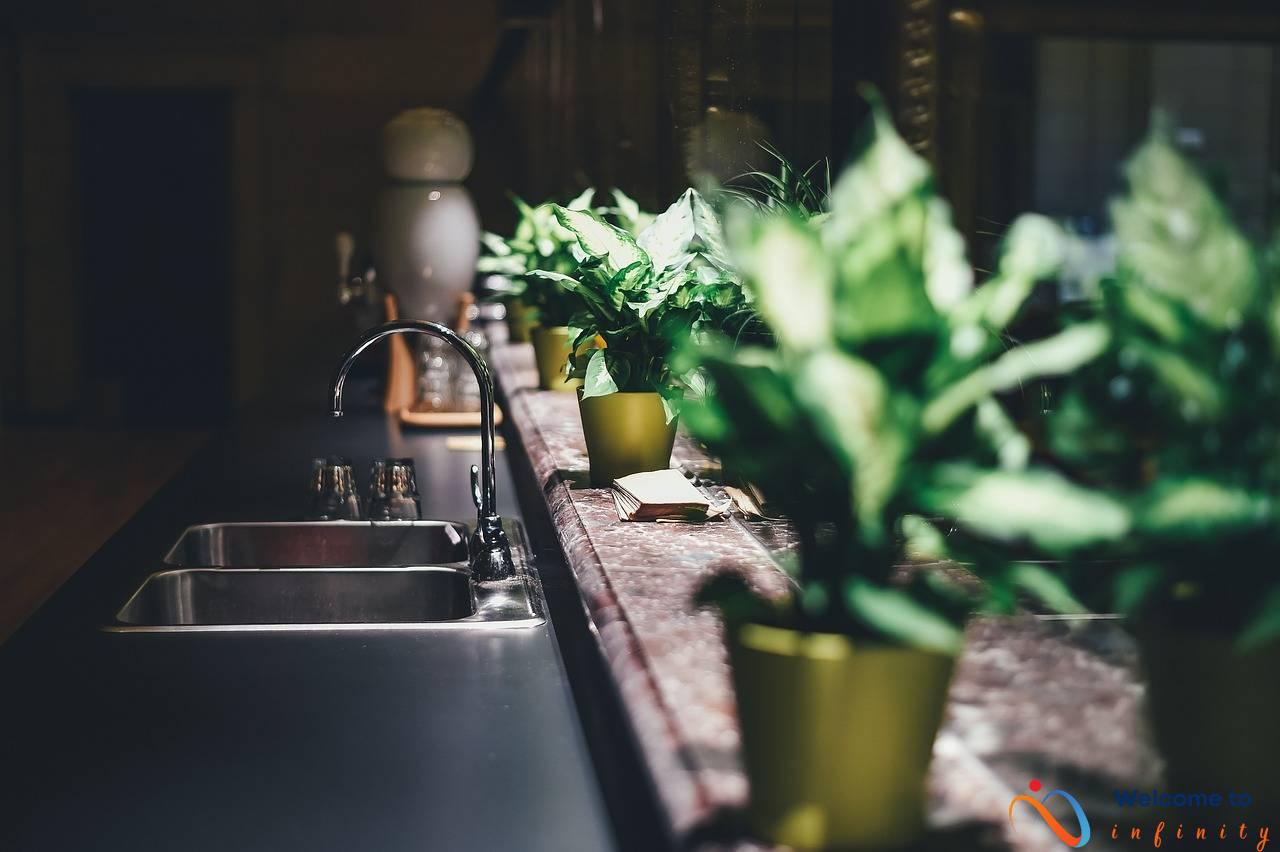If you're looking to reduce your environmental impact and live a more sustainable lifestyle, making changes within your home is a great place to start. With a few simple tweaks to your daily routine and household habits, you can significantly reduce your energy consumption, conserve water, reduce waste, and even save money on utility bills.
One of the easiest ways to reduce your environmental impact is to focus on reducing your energy consumption. There are a variety of small changes you can make to your daily routine that can have a big impact on your energy use. For example, switching to energy-efficient LED lightbulbs can help cut down on electricity usage, while unplugging electronics when they're not in use can also help save energy and reduce your electricity bill over time.
Water conservation is another critical aspect of sustainable living, particularly in areas experiencing water scarcity. Installing low-flow showerheads and faucets can significantly reduce water consumption without sacrificing water pressure, while collecting and reusing rainwater for watering plants is a simple way to decrease reliance on the municipal water supply.
In addition to reducing energy and water consumption, adopting the 3 R's of sustainable waste management can also help reduce your environmental impact. Avoiding single-use plastics and repurposing items before recycling are simple ways to cut down on waste and encourage a more circular economy.
Finally, choosing eco-friendly products when possible is another effective way to make your home more sustainable. Opting for natural cleaning products and using cloth napkins and towels instead of disposable options can help cut down on waste and reduce chemical exposure in the home.
Reduce Energy Consumption
Reducing energy consumption is not only good for the environment, but it can also save you money on your monthly bills. Small changes in your daily routine can lead to a significant decrease in your energy use. Here are a few tips to help you reduce your energy consumption:
- Switch to LED lightbulbs. Traditional incandescent bulbs waste a lot of energy by producing heat instead of light. LED bulbs use up to 75% less energy and can last 25 times longer than traditional bulbs. This simple switch can help you save money on your energy bills over time and reduce your carbon footprint.
- Unplug electronics when not in use. Even when turned off, electronics use small amounts of energy and can add up over time. Using a power strip and turning it off when you're not using your electronics can help you save energy and reduce your carbon footprint.
- Adjust your thermostat. Setting your thermostat a few degrees lower in the winter and a few degrees higher in the summer can help you save energy and reduce your energy bills. Using a programmable thermostat can help you save even more energy by automatically adjusting the temperature when you're not home or sleeping.
- Avoid using your appliances during peak energy hours. Using your appliances during peak energy hours can increase your energy bills and strain the electrical grid. Try to use your appliances at non-peak times or use them in a more energy-efficient way.
These small changes can help you reduce your energy consumption and save money on your monthly bills. Remember, every little bit helps when it comes to reducing your carbon footprint and protecting the environment for future generations.
Switch to LED lightbulbs
One of the easiest ways to reduce your energy consumption is by switching to LED lightbulbs. LEDs, or light-emitting diodes, use significantly less energy than traditional incandescent or fluorescent bulbs. This means they are more eco-friendly and can save you money on your energy bill in the long run.
Not only are LEDs more energy-efficient, but they also last longer. Traditional bulbs have a lifespan of around 1,000 hours, while LEDs can last up to 50,000 hours. This means you won't have to replace your lightbulbs as often, further reducing your environmental impact and saving you money.
LEDs also come in a range of colors and styles, making them a versatile choice for any home. They are available in warm or cool tones, and can be found in shapes ranging from standard bulbs to more unique designs. With so many options available, it's easy to find the perfect LED bulb for your home.
- To switch to LED lightbulbs:
- Take an inventory of all the lightbulbs in your home.
- Research which LED bulbs are compatible with your fixtures and desired brightness level.
- Make the switch! Replace all of your traditional lightbulbs with LED bulbs.
LEDs are an easy and cost-effective way to make your home more environmentally-friendly and reduce your energy consumption. By making this simple switch, you can do your part to help the planet and save money at the same time.
Unplug electronics when not in use
One of the easiest ways to reduce your energy consumption and save money on your electricity bill is simply by unplugging electronics when they're not in use. Just because an electronic device is turned off doesn't mean it's not using any energy. In fact, many electronics continue to draw a small amount of standby power even when they're not in use, known as vampire or phantom energy.
You might be surprised at just how much standby power is being used by the devices in your home. According to the U.S. Department of Energy, vampire energy can account for up to 10% of your home's electricity use. To put that into perspective, that's like leaving a 60-watt lightbulb on all day, every day.
That's why it's important to unplug electronics when you're not using them – even small changes like this can add up to significant energy savings over time. To make the process easier, consider using power strips for your electronics. That way, you can turn off multiple devices at once with the flick of a switch.
By unplugging electronics when they're not in use, you not only save money on your electricity bill, but you also reduce your environmental impact. So, next time you're finished with your laptop or phone charger, make sure to unplug it from the wall. Your wallet and the planet will thank you.
Conserve Water
Conserving water is an essential part of sustainable living. By making small changes in your daily routine, you can significantly reduce your water waste and preserve this precious resource. Here are some ways to conserve water:
- Install low-flow showerheads and faucets
- Collect rainwater for watering plants
- Fix leaks promptly
- Be mindful of water usage
Low-flow showerheads and faucets are an excellent way to use less water without sacrificing water pressure. These devices conserve water by controlling the flow rate and reducing the amount of water that is used.
Rainwater harvesting is a simple way to reduce your reliance on municipal water supplies. Collecting rainwater in a barrel or container can help you water your plants and garden more sustainably.
A dripping faucet or leaking toilet can waste a significant amount of water over time. If you notice a leak, fix it promptly to prevent any unnecessary water waste.
Simple changes like turning off the tap while brushing your teeth or using a broom instead of a hose to clean your driveway can make a big difference in your daily water usage.
By implementing these small changes, you can reduce your water consumption and preserve this precious resource. Every drop of water saved is a step towards a more sustainable future.
Install low-flow showerheads and faucets
If you're looking for ways to conserve water and reduce your environmental impact, switching to a low-flow showerhead and faucets is a great place to start.
Low-flow showerheads can help you save hundreds or even thousands of gallons of water each year, and they do so without sacrificing water pressure. Many people worry that low-flow showerheads won't provide enough water pressure for a satisfying shower, but most models now available provide a high-pressure experience that feels just like a traditional showerhead.
Similarly, installing low-flow faucets in your sinks can also help to reduce water waste. Just like with showerheads, most low-flow faucets provide strong water pressure while using far less water than traditional faucets. This simple upgrade can help you save money on your water bill and conserve this precious resource.
When choosing a low-flow showerhead or faucet, make sure to look for models that are WaterSense certified. This certification, which is given out by the EPA, indicates that the product meets certain efficiency standards and will help you save water without sacrificing performance.
Collect rainwater for watering plants
Water conservation is a crucial component of sustainable living. One easy way to reduce water waste is by collecting rainwater for watering plants. Not only does it reduce your reliance on the municipal water supply, but it also saves you money on your water bill.
The process of collecting rainwater is simple. All you need is a rain barrel and a downspout from your gutter system. The rainwater will collect in the barrel and can be easily accessed through a spigot. You can then use the collected rainwater to water your garden and plants instead of using municipal water.
It's important to note that rainwater should only be used for plants and not for human consumption. Also, make sure to position the rain barrel on a flat surface and cover it with a mesh screen to prevent debris and animals from getting inside.
Collecting rainwater not only conserves water but also helps to reduce stormwater runoff, which can cause erosion and flooding in urban areas. It also reduces the demand for municipal water, which in turn reduces the amount of energy needed to treat and distribute water, leading to a decrease in greenhouse gas emissions.
In summary, collecting rainwater is a simple and effective way to reduce your environmental impact and save money. By using rainwater to water your plants, you can reduce your reliance on municipal water, conserve water, and reduce stormwater runoff. So, why not give it a try and start collecting rainwater today?
Reduce, Reuse, Recycle
Living sustainably doesn't mean sacrificing convenience and comfort. A small change in your daily routine can make a big difference in reducing your environmental impact and preserving our planet for future generations. The three R's of sustainable waste management are a great way to implement eco-friendly practices into your life, and they are easy to remember: reduce, reuse, and recycle.
Reducing waste is the first step in sustainable waste management. It involves minimizing the amount of waste produced in the first place. One way to achieve this is by avoiding single-use plastics. Bring your reusable containers to the grocery store instead of purchasing disposable plastic bags and bottles. Choose products with minimal packaging, and buy in bulk to reduce packaging waste. Repurposing items is another way to reduce waste. Get creative and find new uses for items instead of throwing them away.
Reusing items is the second step in sustainable waste management. Instead of discarding items after one use, find ways to repurpose them. For example, turn an old T-shirt into a cleaning rag or scrap fabric into reusable grocery bags. Donate usable items to local charities or thrift stores instead of tossing them in the trash.
Recycling is the final step in sustainable waste management. It involves breaking down materials and repurposing them to create new products. Recycling reduces the amount of waste that ends up in landfills and conserves natural resources. Check with your local municipal waste management system to learn what materials can be recycled and how. Some items, such as electronics and batteries, require special handling.
By following the three R's of sustainable waste management, you can significantly reduce your environmental footprint. Not only are you saving resources and minimizing waste, but you are also setting an example for others to follow. Remember, small changes can lead to big impacts.
Avoid single-use plastics
Avoid Single-Use Plastics for A Greener Future
Single-use plastics, including straws, bags, and water bottles, are a major source of plastic waste that is polluting our oceans and harming marine life. By finding alternatives to these disposable items, we can significantly reduce our environmental impact.
One of the simplest ways to avoid single-use plastics is by using reusable containers and bags. Invest in a good quality water bottle, coffee cup, and food containers that you can bring with you wherever you go. Not only will you be reducing plastic waste, but you'll also save money in the long run by not having to constantly buy disposable items.
If you often order takeout or delivery, request that your food be packed in reusable containers. Many restaurants are now offering this option as part of their sustainability initiatives. It may seem like a small change, but it can make a big difference when it comes to reducing waste.
In addition, consider purchasing bulk items instead of individually packaged goods. Bring your own containers to the grocery store and fill them up with nuts, grains, and other items. This not only reduces plastic waste but also helps you save money by buying in bulk.
By avoiding single-use plastics, we can create a cleaner and greener future for ourselves and future generations. It may take some effort to make the switch to reusable items, but it is a small price to pay for the health of our planet.
Repurpose items before recycling
Before you think about throwing away that old t-shirt or cardboard box, consider if it could be repurposed for another use. Repurposing items is a great way to reduce waste and save money. Here are some creative ideas to get you started:
- Use old t-shirts as cleaning rags.
- Turn an old ladder into a bookshelf or plant stand.
- Use glass jars as storage containers or candle holders.
- Repurpose cardboard boxes into storage bins or planters.
- Make a collage out of old magazines or newspapers.
- Use egg cartons as seed starters for your garden.
With a little creativity, there are endless possibilities for repurposing items and reducing waste. Before you recycle or throw something away, take a moment to think about how it could be repurposed for another use. You might be surprised at what you can come up with!
Eco-Friendly Products
Eco-friendly products are a great way to reduce your environmental impact without sacrificing quality or convenience. From cleaning supplies to personal care items, there are a variety of eco-friendly products on the market that are both effective and sustainable. Choosing the right products can make a big difference in reducing your carbon footprint and protecting the planet.
One easy way to start using eco-friendly products is to switch to natural cleaning supplies. Harsh chemicals found in traditional cleaning products can be harmful to both the environment and your health. Opt for products made from natural ingredients like vinegar, baking soda, and essential oils. These are just as effective as traditional cleaning products, and they won't fill your home with toxic fumes.
Another simple change you can make is to use cloth napkins and towels instead of paper. Paper products contribute to deforestation, and they can take years to break down in landfills. Cloth alternatives are eco-friendly, reusable, and will save you money in the long run. They're also available in a range of colors and styles to fit any décor.
If you're looking to make a greater impact, consider using eco-friendly personal care items. These include soaps, shampoos, and other products made from natural, non-toxic ingredients. Not only are these products better for the environment, but they're also gentler on your skin and hair. You can also look for products with minimal packaging, such as bar soaps and solid shampoos, to reduce waste.
Finally, consider using eco-friendly pet products if you have furry friends at home. Many pet products are made with harmful chemicals that can be toxic to both your pet and the environment. Look for products made from natural, sustainable materials, such as bamboo or organic cotton. These products are just as effective as traditional pet products, and they're better for your pet's health and the planet.
Choose natural cleaning products
Cleaning products play a big role in our daily lives, but did you know that many common household cleaners contain harsh chemicals that can harm both your health and the environment? By choosing natural cleaning products, you can reduce your exposure to these harmful chemicals and help protect the planet.
Natural cleaning products are made with plant-based ingredients and avoid the use of harsh chemical additives. They are often biodegradable and come in recyclable packaging, making them a much more sustainable choice than traditional cleaners.
When shopping for natural cleaning products, be sure to look for labels that indicate the product is certified organic or made with natural ingredients. Some popular natural cleaning brands include Seventh Generation, Mrs. Meyers, and Method.
| Benefits of Natural Cleaning Products | Benefits of Traditional Cleaning Products |
|---|---|
| -Safer for human health -Safer for the environment -Different scent options -Biodegradable -Plant-based ingredients |
-Cheaper -Wider variety of products -Stronger cleaning power -Easily available |
Choosing natural cleaning products is just one small change you can make to live a more sustainable lifestyle. Not only do they provide a safer and healthier option for your home and family, but they also benefit the planet by reducing the amount of harmful chemicals entering our water systems. Start making the switch today and see how easy it is to do your part for the environment.
Use cloth napkins and towels
Did you know that the average person uses around 2,200 paper towels a year? That's a lot of paper waste! One easy way to reduce your paper waste and save money in the long run is by switching to cloth napkins and towels.
Cloth napkins and towels can be washed and reused multiple times, reducing the amount of paper waste in landfills. Plus, they add a touch of elegance to any dinner table.
If you're worried about the cost, don't be. Cloth napkins and towels are a one-time investment that can last for years. You can even make your own by using old fabrics or clothes you no longer wear.
Other benefits of using cloth napkins and towels include reducing the amount of bleach and chemicals released into the environment during the manufacturing of paper products, as well as reducing the amount of trees harvested each year for paper production.
So ditch the paper towels and napkins and make the switch to cloth. Your wallet and the environment will thank you.












